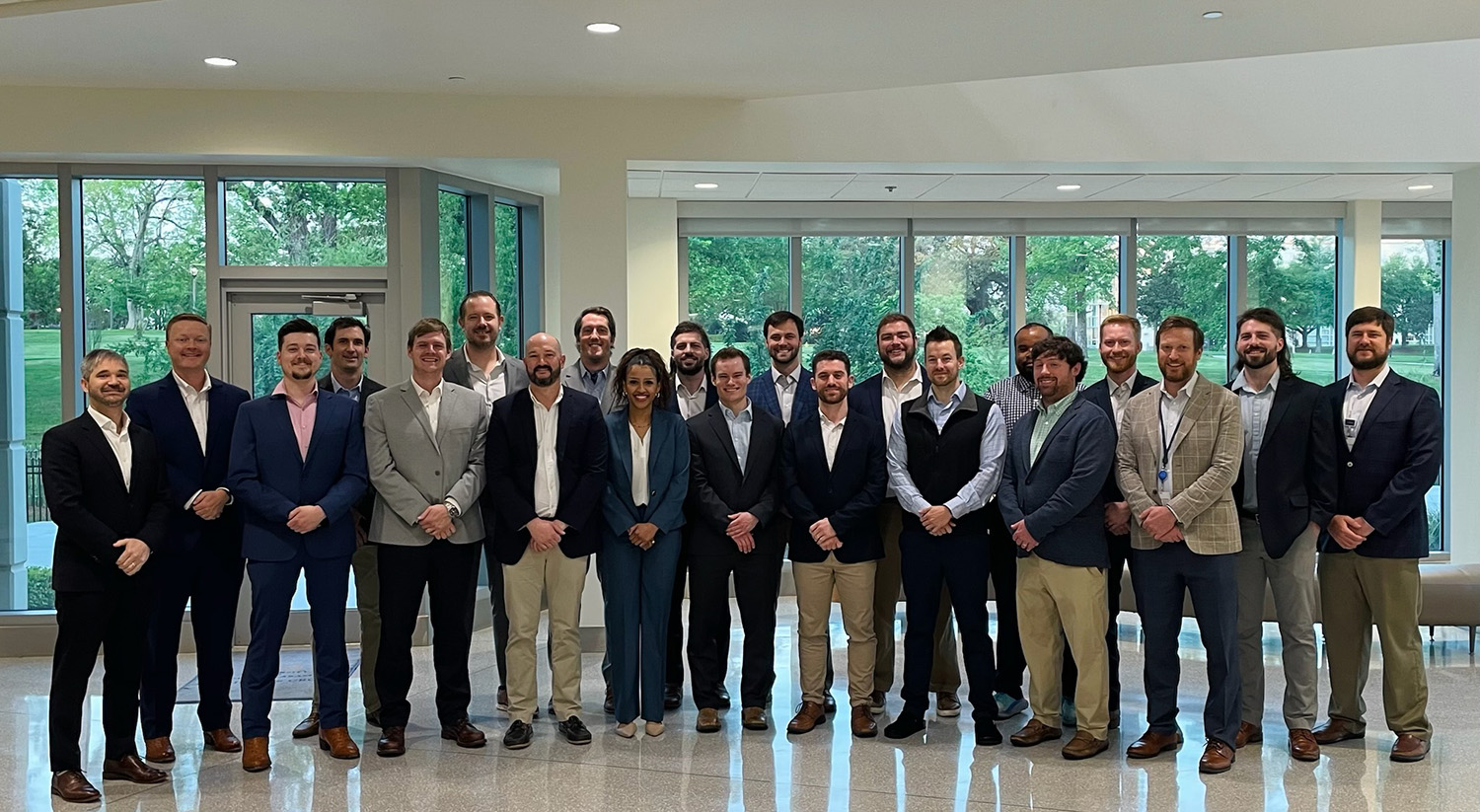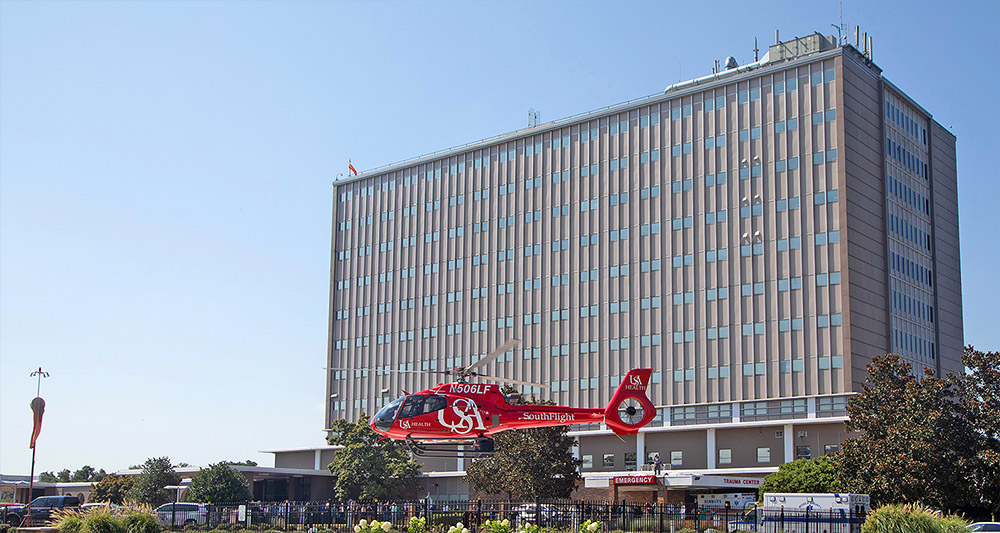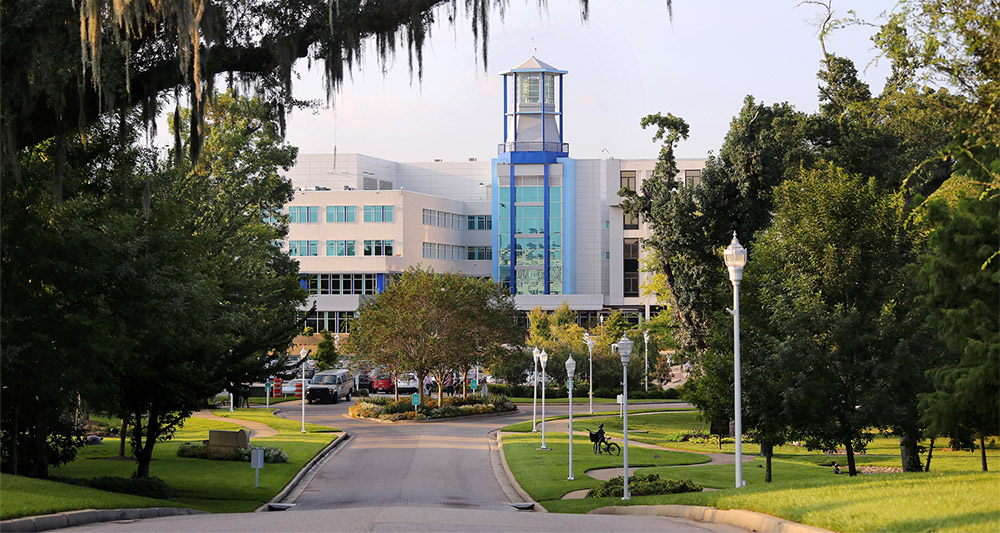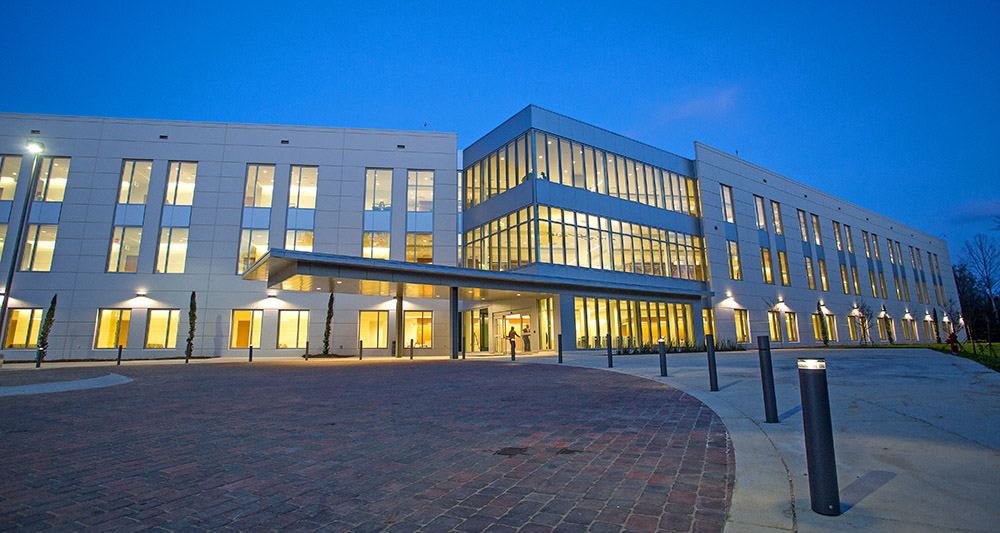Orthopaedic Surgery Residency Program
Find out about the Orthopaedic Surgery Residency Program from our residents and faculty.
Learn more about residencies and fellowships at the University of South Alabama and life on the Gulf Coast.
Message from the Program Director

Welcome to the USA Health Orthopaedic Surgery Residency Program.
We know that trying to choose the next step in your career is a daunting task. The next few years of your life will be critical to your development as a physician as a whole, but more so in your growth as an orthopaedic surgeon.
We believe that our small comprehensive, ACGME-approved training program, offers several unique strengths that will set us apart from the larger institutions. Our one-on-one attending to resident ratio on each rotation allows for progressive and graduated responsibility in patient care. Our blend of academic practice with community rotations offers a broader picture than most academic institutions have to offer. Our high case volume provides each resident with ample experience to develop their surgical skills early in their education.
USA Health is an excellent place to train and our Orthopaedic Surgery Residency Program will provide you with the knowledge and experience you need to further your career. We appreciate your interest in our program and look forward to hearing from you.
Jess Mullens, M.D.
Program Director
Program Overview
Our program is a dynamic five-year curriculum that includes twelve months of combined orthopaedic and general surgery education and four years of direct orthopaedic education. We offer complex integration with the community where these is a wealth of superbly trained surgeons eager to teach. During the PGY-4 year, residents work with Dr. Brad Clay, team orthopaedic surgeon for the University of South Alabama athletic department, covering division IA athletics. The University’s athletic program consists of seventeen USA Jaguars men’s and women’s teams that compete in the Sun Belt Conference.
Our program is fully accredited by the Accreditation Council for Graduate Medical Education (ACGME). During the five-year program of residency training at the University of South Alabama, residents study the prevention of musculoskeletal diseases, disorders, and injuries and their treatment by medical, surgical, and physical methods.
We accept three (PGY-1) residents each year through the Electronic Residency Application Service (ERAS). Candidate selection is based on letters of recommendation, publications, presentations, grades, board scores, and extracurricular activities. Upon final review of the applications, the invitation for a personal interview is extended to approximately 45 young men and women from across the U.S. Our program fully participates in the National Resident Matching Program (NRMP). For details and complete information on how to apply to the University of South Alabama Department of Orthopaedic Surgery Residency Program, please contact your medical school.
Again, thank you for your interest in our program and best wishes for a bright and successful future in orthopaedic surgery.
Mission Statement
The University of South Alabama Department of Orthopaedic Surgery's mission is to commit to improving the lives of all we serve by making quality musculoskeletal care accessible to our entire community while inspiring the next generation through education and research.
We strive to provide an academic environment for achieving excellence in the diagnostic, cognitive, therapeutic and technical skills essential in the treatment of congenital, acquired, traumatic, infectious and degenerative diseases and conditions affecting the musculoskeletal system.
Graduates will have a strong foundation in orthopaedic surgery that will allow them to pursue a variety of career pathways within the specialty. Many of our graduates will continue to serve in our region which is historically medically underserved. In accordance with the Accreditation Council on Graduate Medical Education, our aim is to prove competency in the areas of Patient Care, Medical Knowledge, Systems-Based Practice, Practice-Based Learning and Improvement, Professionalism, and Interpersonal and Communication Skills.
Aims
- To educate residents on the variety of resources available throughout the University system and the community at large and to use them effectively while promoting interaction between all members of the healthcare team.
- To educate residents to provide skills and compassionate care to our diverse patient population.
- To obtain the knowledge necessary for the diagnostic and treatment options for orthopaedic problems within an environment that supports lifelong learning.
- Demonstrate interpersonal skills and professionalism necessary to educate a patient on their diagnosis, treatment options, and outcomes.
Rotation Schedule
The residency program at the University of South Alabama Department of Orthopaedic Surgery is comprehensive and provides a broad educational experience combining academic as well as community-based rotations. Our schedule was designed to provide a well-rounded orthopaedic training experience. All orthopaedic subspecialties are covered.
Internship: Post-Graduate Year (PGY) 1
The ACGME requires 12 months of general education. Our program satisfies this requirement during the intern year. The first year of our comprehensive training is divided into thirteen four-week blocks in a variety of services relevant to the care of patients and focusing on the development of skills which are expected of an orthopaedic surgery resident. It should be noted that the trauma rotations during the PGY-1, PGY-2, and PGY-5 years are conducted at the only Level 1 trauma center in the Gulf Coast area.
Non-orthopaedic rotations:
- Anesthesiology
- General Surgery (2 months)
- Musculoskeletal Radiology
- Plastic Surgery
- Surgical Intensive Care Unit
Orthopaedic rotations:
- Orthopaedic Experience for Interns
- Orthopaedic Trauma (2 months)
- Pediatric Orthopaedics (2 months)
- Spine/Neurosurgery (2 months)
Junior Resident Rotations
Following the PGY-1 year, all remaining rotations are within the Department of Orthopaedic Surgery. Rotations are organized to insure increasing responsibility and exposure to all aspects of orthopaedics as residents expand their knowledge base, surgical skills, and maturity. This schedule gives the resident ample hands-on patient care and operative experience. Each resident is given sufficient graduated responsibility and ample opportunity to make important clinical decisions and perform a variety of major and minor orthopaedic procedures. Responsibility progresses with increasing knowledge and skill level in the setting of an encouraging faculty and the caring environment of a hospital with experienced and academically engaged attending staff. The formal residency begins as a PGY-2.
PGY-2 Year:
- Adult Reconstruction
- Foot & Ankle
- Hand/Upper Extremity
- Night Float
- Orthopaedic Trauma
PGY-3 Year:
- Adult Reconstruction
- Elective
- Night Float
- Pediatric Orthopaedics
- Sports Medicine
Senior Resident Rotations
The senior years of residency training are designed to continue the expansion of surgical skills and orthopaedic knowledge. Residents are given graduated responsibility to become more active and independent in patient care decisions.
PGY-4 Year:
- Adult Reconstruction
- Orthopaedic Trauma
- Sports Medicine/Shoulder
All three PGY-5 residents share the Administrative Chief Resident responsibilities. They are given advanced responsibilities in teaching, organization, and administration. The Chief Residents work closely with the Program Director and the Program Coordinator to provide continuous resident feedback about the program.
PGY-5 Year:
- Elective
- Foot & Ankle
- Hand
- Pediatric Orthopaedics
- Research
- Spine
As a resident in the University of South Alabama Department of Orthopaedic Surgery, you will gain the benefits of private programs as you have the option to rotate with a variety of nearby orthopaedic groups. We feel that this is one of the highlights of our program as you will be exposed to both the academic and private practice aspects of orthopaedic surgery.
Two of the local groups that we spend time with are the Alabama Orthopaedic Clinic and The Orthopaedic Group. Both of these groups operate at Mobile Infirmary Medical Center, which is located next door to USA Health Children’s & Women’s Hospital. Many of the surgeons in these groups have close ties with our program as several are alumni. They are more than eager to have residents rotate on their services, and they frequently attend our weekly Grand Rounds and monthly Journal Club meetings.

USA Health University Hospital is an acute care center serving as the major referral center for Southern Alabama, Southern Mississippi, and portions of Northwest Florida.
University Hospital houses a Level 1 Trauma Center as well as a Regional Burn Center. Twenty-five percent of admissions to this facility are through the Trauma Center. Of the 100 teaching hospitals nationwide, USA Health University Hospital is third in the acuity index measuring the severity of patient illnesses.

USA Health Children’s and Women’s Hospital is among a handful of freestanding hospitals in the United States dedicated specifically to the health care needs of children and women. The hospital offers highly regarded surgical, oncological, clinical and acute care to women and children. Our team of physician specialists, nurses, and technicians care for the medical needs to women and children with a family-centered approach.
 The USA Health Strada Patient Care Center is home to 100 multispecialty services all in one location. Our 133,000-square-foot
facility offers patients access to care in one of 153 exam rooms. With state-of-the-art
equipment, our physicians and care providers deliver advanced treatments and procedures
to patients from Mobile and surrounding areas.
The USA Health Strada Patient Care Center is home to 100 multispecialty services all in one location. Our 133,000-square-foot
facility offers patients access to care in one of 153 exam rooms. With state-of-the-art
equipment, our physicians and care providers deliver advanced treatments and procedures
to patients from Mobile and surrounding areas.
Current Orthopaedic Surgery Residents
View photos and profiles of the program's 15 current residents.
Former Graduates and Fellowship Information
1978
- Dr. Dalton R. Carpenter
- Dr. William A. Crotwell III (Hand, Southern Baptist Hospital)
1979
- Dr. John R. Humphries
1980
- Dr. Prasit Nimityongskul (Pediatrics, A I Dupont Institute)
- Dr. Robert J. Zarzour
1981
- Dr. Bruce L. Smith, Jr.
1982
- Dr. Stephen P. Cowley
1983
- Dr. James R. Wilkinson
1984
- Dr. H. Victor Allen, III
- Dr. David W. Bacastow
1985
- Dr. Norman S. Lichtenfeld
- Dr. William L. Montague, Jr.
1986
- Dr. Gilbert R. Holland
- Dr. James M. Johnston
1987
- Dr. Andre J. Fontana
- Dr. James L. West III (Spine, Twin Cities Spine Center)
1988
- Dr. Roger M. Setzler
- Dr. Suanne White-Spunner
1989
- Dr. Samuel Goldstein
- Dr. Joseph F. McGowin
1990
- Dr. Clark S. Metzger (Spine, University of Pittsburgh)
- Dr. James F. Scoggin III
1991
- Dr. A. Brent Bankston (Adult Reconstruction, Center for Hip and Knee Surgery)
- Dr. James Michael Cockrell (Sports Medicine, Piedmont Hospital)
1992
- Dr. William J. Bose (Adult Reconstruction, University of Florida)
- Dr. Russell Alan Hudgens
1993
- Dr. David R. Hardin
- Dr. Mark R. Hedrick (Foot & Ankle, Emory University)
1994
- Dr. Phillip R. Bacilla
- Dr. Tamara Denise Clancy (Hand , University of Florida)
1995
- Dr. Leroy S. Atkins
- Dr. Robert Dean Lolley
1996
- Dr. Thomas Scott Ellison (Spine, Carolinas Medical Center)
- Dr. Mark H. Field (Shoulder, Elbow & Knee, Mississippi Sports Medicine & Orthopaedic Clinic)
- Dr. H. Lawrence Haydel
1997
- Dr. Brett J. Chiasson (Adult Reconstruction, University of Florida)
- Dr. Bendt P. Petersen (Spine, Harvard Medical School)
1998
- Dr. Barton S. Arthur
- Dr. Tim S. Revels (Spine, Louisiana State University)
1999
- Dr. R. Lance Johansen (Adult Reconstruction, Florida Orthopaedic Institute)
- Dr. Scott Everett Strohmeyer (Spine, Louisiana State University)
2000
- Dr. Coleman D. Fowble (Trauma, Harborview Medical Center)
- Dr. L. Dean Mason II
2001
- Dr. William C. Cottrell (Sports Medicine, American Sports Medicine Institute)
- Dr. Anthony L. Tropeano (Sports Medicine, American Sports Medicine Institute)
2002
- Dr. Mark Todd Caylor
- Dr. David A. Stokes (Sports Medicine, Mississippi Sports Medicine & Orthopaedic Clinic)
2003
- Dr. Chad L. Loup
- Dr. William C. Mayfield III (Sports Medicine, Cincinnati Sports Medicine)
2004
- Dr. Christopher E. Cenac, Jr. (Spine, Baylor College of Medicine)
- Dr. David G. Lemak (Sports Medicine, American Sports Medicine Institute)
2005
- Dr. Ginger Kay Bryant (Trauma, Harborview Medical Center)
- Dr. Christopher A. Jarrett (Adult Reconstruction, Ranawat Orthopaedic Center)
2006
- Dr. Jared J. Patterson (Adults Reconstruction, Florida Orthopaedic Institute)
- Dr. Ramon F. Rodriguez (Foot & Ankle, American Sports Medicine Institute)
2007
- Dr. Todd Brian Edmiston (Joint Replacement & Sports Medicine, Orthopaedic Sports Medicine Clinic of Alabama)
- Dr. Clinton W. Howard IV (Spine, The Foundation for Orthopaedic and Athletic-Related Research at Baylor College of Medicine and the University of Texas M.D. Anderson Cancer Center)
2008
- Dr. Matthew Daniel Barber (Joint Replacement, Arizona Institute for Bone & Joint Disorders)
- Dr. James Donald Smith (Spine, Leatherman Spine Institute)
2009
- Dr. Rebel Huffman (Hand & Upper Extremity, Baptist Integris)
- Dr. Jason Randall
2010
- Dr. Amanda M. Ivy (Sports Medicine, Methodist Sports Medicine)
- Dr. Zachary B. Scheer (Total Joint Replacement, The CORE Institute)
2011
- Dr. Adam Jay Handwerger (Pediatrics Orthopaedics, Scottish Rite Children’s Hospital)
- Dr. Dennis K. Jorgensen
- Dr. Glenn "Lee" Wilson
2012
- Dr. Timothy Frerichs (Foot & Ankle, Desert Orthopaedic Center; Sports Medicine, The Andrews Institute)
- Dr. David Lee Smith (Trauma, University of Missouri)
- Dr. Daniel Wittershiem (Adult Reconstruction, The Hedley Orthopaedic Institute)
2013
- Dr. Jared Locke Burkett (Hand & Upper Extremity, University of Mississippi Medical Center)
- Dr. Raul Curiel (Sports Medicine, The CORE Institute)
- Dr. Grantham McAleer Shell (Foot & Ankle, University of Alabama – Birmingham)
2014
- Dr. Filippo C. Chillemi (Sports Medicine, The Andrews Institute)
- Dr. Ryan C. Palmer
- Dr. Goeffrey P. Stone (Shoulder & Elbow, Florida Orthopaedic Institute)
2015
- Dr. Russell Douglas Goode (Trauma, University of Missouri)
- Dr. Aaron Kyle Mates (Foot & Ankle, The Andrews Institute)
- Dr. John D. Tullos (Sports Medicine, Mississippi Sports Medicine & Orthopaedic Clinic)
2016
- Dr. W Ryan Mitchell (Sports Medicine, Sports Orthopaedics & Rehabilitation Medicine (SOAR))
- Dr. Brandon A Taylor (Foot & Ankle, Campbell Clinic)
- Dr. J Grant Zarzour (Adult Reconstruction, Mississippi Sports Medicine & Orthopaedic Clinic)
2017
- Dr. Jess H Mullens (Foot & Ankle, The Steadman Clinic)
- Dr. Brandon R Scott (Trauma, University of Kentucky)
- Dr. Stephen D White (Foot & Ankle, OrthoCarolina)
2018
- Dr. Navkirat S. Bajwa (Spine, Case Western Reserve/Cleveland Clinic)
- Dr. Patrick S. Barousse (Foot & Ankle, University of California – Davis/Reno Orthopaedic Clinic)
- Dr. Patrick J. Smith (Sports Medicine, Campbell Clinic)
2019
- Dr. Alexander H. MacDonell (Foot & Ankle, University of Pittsburgh Medical Center)
- Dr. Stephanie S. Pearce (Pediatric Orthopaedics, Children’s Hospital of Colorado, 2019; Sports Medicine, Steadman Philippon Research Institute, 2020)
- Dr. Joseph R. Shung (Hand, University of Mississippi Medical Center)
2020
- Dr. Jonathan Gillig (Adult Reconstruction, Norton Orthopaedic Specialists)
- Dr. Daniel Kim (Spine, Twin Cities Spine Center)
- Dr. Anna Rambo (Pediatric Orthopaedics, Campbell Clinic)
2021
- Dr. Wesley Honeycutt (Trauma, Emory University)
- Dr. Zach Moore (Sports Medicine, American Sports Medicine Institute)
- Dr. Mark Prevost (Spine, Texas Back Institute)
2022
- Dr. William A. Cutchen (Pediatric Orthopaedics, Children’s National Hospital)
- Dr. Scott R. Glenzer (Hand, University of Mississippi Medical Center)
- Dr. Nathanael D. Sbravati (Adult Reconstruction, Prisma Health Steadman Hawkins Clinic)
2023
- Dr. Kyle G. Cox (Sports Medicine, American Sports Medicine Institute)
- Dr. Sean M. Farrell (Hand, University of Alabama Medical Center)
- Dr. Richard D. Williams (Trauma, Sonoran Orthopaedic Trauma Surgeons)
2024
- Dr. Joseph W. Anderson (Sports Medicine, University of Missouri)
- Dr. Wade T. Massey (Foot & Ankle, Baptist Health South Florida)
- Dr. David Michaeli (Trauma, University of Texas Health Science Center at San Antonio)
2025
- Dr. T. Kyle Summers (Hand, University of Tennessee – Campbell Clinic)
- Dr. Jesse J. Trent (Foot & Ankle, University of Tennessee – Campbell Clinic)
- Dr. Patrick G. Young (Spine, Steadman Philippon Research Institute)
Call
Call during the week is from 6 a.m. until 6 p.m. and is covered by the orthopaedic trauma junior resident at University Hospital. The pediatric orthopaedic junior resident covers call at Children’s and Women’s Hospital. The night float resident is responsible for call at both hospitals from 6 p.m. until 6 a.m. Junior resident weekend call consists of Friday night 6 p.m. until 6 a.m. and Sunday day from 6 a.m. until 6 p.m. and a 24-hour Saturday call. Home call is utilized for senior call schedules.
Mileage Reimbursement
Orthopaedic residents are eligible for mileage reimbursement for travel while on call.
Vacation
Four weeks of vacation per year are divided as one week of vacation per quarter. While on vacation, the resident is also off call the weekend before and after.
Moving
A moving stipend of $2.00 a mile (up to $1200) is provided to each resident who has to relocate.
Travel
Each resident will attend one course per year that is sponsored by the department in addition to a board review course as a PGY-5. If a resident has research that is accepted for presentation, the department will cover cost of the trip including travel, housing, and a daily per diem for food.
Fitness Center
Access to the University of South Alabama Recreational Facility is provided to residents for $10 per month.
Sports Medicine
The orthopaedic residents here at the University of South Alabama have the ability to be on the sidelines to cover USA football and USA basketball games – division 1 sports in the Sun Belt Conference.
Community Physicians
All residents are given the opportunity to operate with community orthopedic surgeons from the PGY-2 year until completion of the program.
Surgical Skills Lab
The Department of Orthopaedic Surgery has access to cadavers for dissection, open approaches, and arthroscopic training on an as-needed basis. The department has an arthroscopic simulator as well.
Scrubs and White Coats
At the beginning of the PGY-1 year, interns get three white coats and three pairs of scrubs. At the beginning of each academic year, each resident gets a new white coat OR a new pair of scrubs. The department offers free laundry service for cleaning of white coats.
Journal Subscription
The department provides each resident with a subscription to Journal of Bone and Joint Surgery and the AAOS Yellow Journal.
Parking
Free parking adjacent to both hospitals as well as the Strada Patient Care Center.
For those interested in the USA Health Orthopaedic Surgery Residency Program, applications must be submitted through the Electronic Residency Application Service (ERAS) no later than October 1st of each academic year. Each applicant must have the following documents on file no later than the stated deadline:
- ERAS Application
- Personal Statement
- Medical School Transcript
- MSPE
- USMLE Transcript
- Letters of Recommendation (3 minimum)
The decision to offer an applicant an interview is completed as soon as all applications have been reviewed. Each applicant will receive an email giving the state of their application: invited for an interview, placed on the wait list, or a notice of rejection. Applicants on the wait list will be contacted second time to offer them an interview slot that has opened or to notify them that the interview process has ended.
FAQs
1. All applicants participating in the couple’s match must list their partner’s name and specialty on their application.
2. Any applicant not having taken Step 2CK by December 1st should send an email indicating the scheduled test date for the exam.
3. Any applicant who has not taken and passed Step 2CK by the time the rank list is due will not be ranked.
4. Each applicant should submit at least three LoRs. We do not require a department chair or program director letter, nor do we require that the letters should all be from a surgical program.
5. The University of South Alabama Department of Orthopaedic Surgery will not be accepting applications from students who are enrolled in or have graduated from foreign medical schools beginning with the 2016 Match.
Program Director: Jess Mullens, M.D.
Assistant Program Directors: William Cutchen, M.D., and Tyler McDonald, M.D.
Program Coordinator: Rhonda Smith
Mailing address:
USA Department of Orthopaedic Surgery
ATTN: Rhonda B. Smith, GME Program Coordinator
1601 Center St, #N-3104
Mobile, AL 36604
Email: RhondaSmith@health.southalabama.edu
Phone: (251) 665-8251
Fax: (251) 665-8265


